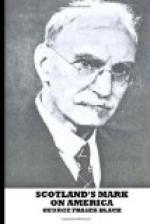invented and patented an improvement in cotton-gins
called the “breast-roller,” also a portable
steam saw-mill. As early as 1790 he was at work
on the problem of the application of steam power to
the propulsion of boats, but lack of funds prevented
operations until 1807, the same year in which Fulton
launched his steamboat. His son, Augustus Baldwin
Longstreet (1790-1870), became President of South
Carolina College. Robert Fulton (1765-1815), of
Ayrshire origin through Ulster, was, as every one knows,
the first to successfully apply steam to navigation.
Hugh Maxwell (1777-1860), publisher and newspaper
editor, of Scottish descent, invented the “printer’s
roller” (patented in 1817), cast his own types
and engraved his own woodcuts. Henry Burden (1791-1871),
born in Dunblane, inventor of an improved plow and
the first cultivator, was also the first to invent
and make the hook-headed railroad spike “which
has since proved itself a most important factor in
railroad building in the United States.”
His “cigar boat” although not a commercial
success was the fore-runner of the “whale-back”
steamers now in use on the Great Lakes. William
Orr (1808-91), manufacturer and inventor, born in
Belfast of Ulster Scot parentage, was the first to
manufacture merchantable printing paper with wood
fibre in it, and made several other improvements and
discoveries along similar lines. Cyrus Hall McCormick
(1809-84), inventor of the reaping machine, was descended
from James McCormick, one of the signers of the address
of the city and garrison of Londonderry presented
to William III. after the siege in 1689. Of his
invention the French Academy of Sciences declared
that by its means he had “done more for the cause
of agriculture than any other living man.”
James Blair (1804-84), born in Perth, Scotland, was
the inventor of the roller for printing calico; and
Robert M. Dalzell (1793-1873) was inventor of the
“elevator system” in handling and storing
grain. Samuel Colt (1814-62), inventor of the
Colt revolver, and founder of the great arms factory
at Hartford, Conn., was of Scots ancestry on both
sides. He was also the first to lay a submarine
electric cable (in 1843) connecting New York city with
stations on Fire Island and Coney Island. Thomas
Taylor, inventor of electric appliances for exploding
powder in mining, blasting, etc., Chief of the
Division of Microscopy (1871-95), was born in Perth,
Scotland, in 1820. Duncan H. Campbell, born in
Greenock in 1827, settled in Boston as a lad, by his
numerous inventions, “pegging machines, stitching
machines, a lock-stitch machine for sewing uppers,
a machine for using waxed threads, a machine for covering
buttons with cloth,” laid the foundation of
New England’s pre-eminence in shoe manufacturing.
Gordon McKay (1821-1903), by his inventions along
similar lines also helped to build up New England’s
great industry. Robert Dick, (1814-93), born
in Bathgate, Linlithgowshire, died in Buffalo, lecturer,
newspaper editor, writer, preacher, and inventor,




